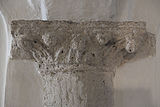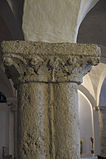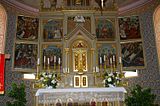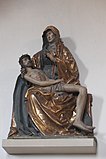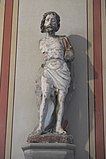St. Arsatius (Ilmmünster)
The Catholic parish and former collegiate church of St. Arsatius in Ilmmünster , a municipality in the Upper Bavarian district of Pfaffenhofen an der Ilm , was built at the beginning of the 13th century on the site of a Carolingian predecessor building from the 8th or 9th century. The church is one of the protected architectural monuments in Bavaria.
history
The Carolingian predecessor church was built for the Benedictine monastery Ilmmünster , which was founded in the 8th century as a branch monastery of Tegernsee and which was secularized by the Bavarian Duke Arnulf I in the 10th century . A canon monastery was established there around 1060 , which flourished in the 13th century. The Romanesque Arsatius Church was built for this monastery around 1210/20 . In 1492 Duke Albrecht IV moved the collegiate monastery together with the Schliersee monastery to the newly built Frauenkirche in Munich, which Ilmmünster was subject to until it was secularized in 1803. It was not until this year that Ilmmünster became an independent parish and St. Arsatius parish church .
Over time, the church underwent significant changes. Around 1475 it was furnished in a late Gothic style, in 1676 it received a vault and windows in the Baroque style and in 1746 it was decorated with rich stucco . Between 1875 and 1878 the church was re-romanised. The stucco from the Baroque period was replaced by frescoes by Johann Michael Wittmer . During the renovation between 1975 and 1984, it was decided to restore the neo-Romanesque appearance.
Saint Arsatius
The church is consecrated to St. Arsatius , whose bones were transferred from Rome to the newly founded Ilmmünster monastery around 766 , as the copy of a funerary inscription from the 11th century testifies. In the Freising calendar from around 980 Arsatius is listed as "Confessor" ( confessor ), in the 13th century he is called a bishop. Essentially, his vita, which cannot be historically proven, was recorded in the 15th century, according to which Arsatius and the Milanese Bishop Eustorgius are said to have brought the relics of the Three Kings and the Brazen Serpent of Moses from Constantinople to Milan. In 1495, after the collegiate monastery had been relocated to Munich a few years earlier, the relics of the patron saint of the church were transferred to the Altötting chapel of the Frauenkirche , amid violent protests from the locals . With the removal of the relics, the pilgrimage that had existed since the 9th century also came to a standstill. In 1846 the relics were returned to Ilmmünster, where they have been kept in the church's crypt ever since .
architecture
Exterior construction
The three apses are divided into pilaster strips and half-columns connected by blind arches , some of which have bud capitals . Under the roof approach a tooth extends fries .
The bell tower on the south side, covered with a gable roof, dates from the Gothic period . It is broken up on all four sides by arched sound arcades and is crowned by a stepped gable. The gable field is decorated with dazzling fields that are framed by twin arches. Arched friezes run around the nave on the outer walls .
inner space
The church is laid out as a three-nave pillar basilica with no transepts and three east apses . The originally flat-roofed central nave was vaulted in 1676 with a needle cap barrel. The slightly pointed arcades rest on square pillars with baroque-shaped fighters . The side aisles have groined vaults . During the Baroque period, the windows in the side aisles were enlarged and the upper windows in the central nave were replaced by transversely oval oculi . The choir is nine steps higher.
Hall crypt
The three-nave hall crypt is divided into five bays divided. The groin vault is supported by pillars, some with profiled transom plates, and bundled three-quarter columns with bud capitals. Pilasters and half-columns alternate on the walls .
Furnishing
- During excavations in the area around the choir, several fragments of the choir screen of the Carolingian predecessor church were found. The sandstone slabs are decorated with braided tape and were probably reused in the Romanesque church. A large part of the choir barrier panels is exhibited in the State Archaeological Collection in Munich . A fragment of the choir screen with the so-called Ilmmünster cross is kept in the church.
- The early Gothic choir stalls are dated around 1320.
- Four Gothic carved reliefs attributed to Erasmus Grasser and twelve panels of a Gothic winged altar have been inserted into the neo-Romanesque high altar from 1880 . The four reliefs depict scenes from the legend of St. Arsatius. The painted panels, which are attributed to Jan Polack , depict scenes of the Passion , the episcopal ordination of St. Arsatius and his death as well as the beheading of one of the Magi and the transfer of his bones . The half-life-size figures on the altar, Saint Helena and Saint Elisabeth of Thuringia , date from the early 16th century. In their midst, a seated Mother of God with the baby Jesus on her lap holds a bunch of grapes in her hand. It is dated to the Gothic period.
- A Pietà by Erasmus Grasser from around 1500 and, by the same sculptor, the assistant figures Maria and John on the cross altar in the north aisle have also been preserved from the Gothic interior . The smaller figures on this altar, St. Arsatius, Pope Zacharias , St. Korbinian and St. Benno, also come from the Gothic period.
- The family altar in the south aisle has been preserved from the baroque furnishings of the church.
- On the guild poles from the second half of the 19th century, next to Jesus, are the Archangel Michael , St. Sebastian , St. George , two bishops, St. Rochus of Montpellier and the third of Anna .
organ
The organ, built by Anton Staller in 1985 , has 36 stops on three manuals and a pedal . The disposition is:
|
|
|
|
||||||||||||||||||||||||||||||||||||||||||||||||||||||||||||||||||||||||||||||||||||||||
- Coupling : I / II, III / II, III / I, I / P, II / P, III / P
- Playing aids : 4-fold mechanical setter
- Comments: sliding drawer , mechanical play and electrical stop action
Bells
The existing chime includes six bronze bells. The five largest bells were cast by the Anton Joseph Bachmair foundry in Erding in 1880. The smallest bell, St. Cäcilia, was procured in 1990 as a replacement for the then smallest bell St. Michael (Bachmair, 1880) which was destroyed during the acceptance test in June 1942. The Cecilia bell was manufactured by the Perner foundry in Passau and consecrated on July 26, 1990. The former six-part Bachmair chime was at around 5.5 tons, the second largest ensemble of this foundry after St. Nikolaus in Rosenheim with 7.7 tons, which no longer exists today. The bell from Ilmmünster is today probably the only 5-person ensemble from the 19th century from a single foundry in the Archdiocese of Munich and Freising .
Existing peal
| number | description | inscription | translation |
|---|---|---|---|
| 1 | Arsatius bell, 2462.5 kg, h0,
Bachmair, Erding 1880 |
O Praesul admirabilis - Patronus invinciblis - a fame,
peste libera - a servitute vindica. M (aximus). R (everendus). D (ominus). Josef Fridl Paroch (us). h (uius). l (oci). et Decan (us). una cum A (dmodum). R (everendo). P (atre). Francisco Xaver (io). Kapplmayr Ord (inis). Capucin (orum). Minister). Provinc (ialis). hac sex campanas curavit. |
O miraculous bishop - O unique patron saint -
save us from hunger and plague - free us of bondage. The venerable dean and pastor this place Josef Fridl together with the provincial Franz Xaver Kapplmayr from the Capuchin Order here have six bells attached. |
| 2 | Marienglocke, 1230.5 kg, dis1 (es),
Bachmair, Erding, 1880 |
Ave Maria, gratia plena, Dominus tecum, benedictus fructus
ventris tui, Jesus. A fulgure et tempestate, libera nos Domine Jesus Christ. |
Hail Mary, full of grace, the Lord be with me
Blessed is the fruit of your body, Jesus. Before lightning and storms keep us, Lord Jesus Christ. |
| 3 | Joseph Bell, 745.5 kg, f sharp 1,
Bachmair, Erding, 1880 |
Since Joseph meritis sidera scandere. | Grant, Joseph, that we may go to heaven through Your deeds
come. |
| 4th | Francis bell, 526.0 kg, g sharp1 (as),
Bachmair, Erding, 1880 |
Meritis et precibus S (acro). S (ancti). Franc (isci). Xaverii propitius,
esto, domine, populo tuo. |
Through the favors and intercessions of St. Francis Xavier be you,
Lord, have mercy on your people. |
| 5 | Sacred Heart Bell, 307.5 kg, h1,
Bachmair, Erding, 1880 |
Jesu, cor nostrum visita Regna reclude coelica. Fac iter tutum
superum et claude vias inferum. |
Jesus, enter our hearts, open the kingdom of heaven to us.
Show us a safe way to heaven and shut up our way to hell. |
| 6th | Cecilia bell, 148 kg, dis2,
Perner, Passau, 1990 |
Sancta Caecilia nos sonus tuus semper delectat.
Back: I have called you by name. You are mine |
Saint Cecilia, may your sound always please us.
Back: I have called you by name. You are mine (Isa 43,1) |
Bells 1 to 4 and 6 had to be delivered in 1942. Bell 6 (St. Michael) broke during acceptance. Bells 1 to 4 could be found again in 1947 and brought back. Bell 5 remained on the tower.
Former bell from 1880 destroyed in 1942
| number | description | inscription | translation |
|---|---|---|---|
| 6th | Michael's bell, 142.5 kg, dis2 (es),
Bachmair, Erding, 1880 |
Huc custos pervigil advola. | Hurry here, you always vigilant guardian. |
Bells before 1880
Before 1880 there were five bells totaling 4,034 pounds. The first and second bells bore the inscription: “Ave Maria .... D. tecum. Beno (?) Sebolt poured me in 1415 ”. The third bell read: “Leonhard Strasser poured me AS MDXC (1590). In God's name I, Math. Rothmair, of the time Kirprobst, Leonhard Rhael (?), Lovel (?) Eller Arerari (?) Jesus Nazarenus rex Judaeorum flowed. Hic titulus triumphalis defendat nos nosotosque fructus terrae ab omnibus malis. - Ecce crucem Domini, fugite partes adversae ”. The name of the foundryman, Leonhard Strasser, is "very doubtful" according to Seeanner, he considers Wolfgang Steger to be more likely. The fourth bell was cast by AB Ernst in Munich in 1758. The fifth bell bore the inscription: "Soli Deo - Maria - 1509 Jar".
literature
- Georg Dehio: Handbook of the German art monuments. Bayern IV: Munich and Upper Bavaria . 2nd edition, Deutscher Kunstverlag, Munich 2002, ISBN 3-422-03010-7 , pp. 464–466.
- Jolanda Drexler-Herold, Angelika Wegener-Hüssen: Landkreis Pfaffenhofen ad Ilm (= Bavarian State Office for Monument Preservation [Hrsg.]: Monuments in Bavaria . Volume I.19 ). Karl M. Lipp Verlag, Munich 1992, ISBN 3-87490-570-5 , p. 102-104 .
- Peter Pfister: Ilmmünster . (= Small Art Guide No. 1525), 3rd revised edition, Verlag Schnell and Steiner, Regensburg 1995.
Web links
- Sankt Arsatius Archdiocese of Munich and Freising (accessed on January 3, 2016)
- Ilmmünster Abbey House of Bavarian History (accessed January 3, 2016)
Individual evidence
- ↑ List of monuments for Ilmmünster (PDF) at the Bavarian State Office for Monument Preservation, monument number D-1-86-130-1
- ↑ St. Arsacius Archdiocese of Munich and Freising (accessed on January 3, 2016)
- ↑ Bavarian organ database online
- ↑ a b c d e f g Gerald Fischer, Reinhard Haiplik: The bells of St. Arsatius in Ilmmünster . Parish and Church Foundation St. Arsatius, Ilmmünster (Ed.)
- ↑ a b Bell consecration on July 26, 2009 . Parish and Church Foundation St. Arsatius, Ilmmünster (Ed.)
- ^ A b c d e Matthias Seeanner: The bells of the archdiocese of Munich and Freising . In: Contributions to the history, topography and statistics of the Archdiocese of Munich and Freising . tape 11 (new episode volume 5 ). Munich 1913, p. 288 .
Coordinates: 48 ° 29 ′ 15 ″ N , 11 ° 30 ′ 7 ″ E









